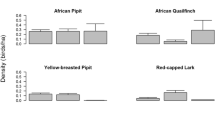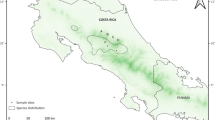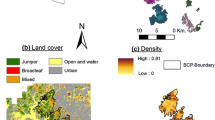Abstract
Density estimation is fundamental for animal conservation. Yet, ignoring the effects of detectability can bias density estimations, resulting in unreliable management strategies for threatened species. We estimated the density of the Sierra Madre Sparrow (Xenospiza baileyi), an endangered species endemic to specific grasslands of Mexico, using hierarchical modelling techniques accounting for detectability and allowing the inclusion of covariates. These models enabled us to analyze the relationship between density and habitat characteristics, therefore providing robust estimations under different habitat scenarios. Moreover, we measured the remaining surface of subalpine grassland across central Mexico to estimate the population size of the species. We performed the study by including local community members that were familiar with the studied species in the definition of research objectives, bird surveys, and habitat characterization. We found that herb cover had a positive effect on the density of the sparrow. Hence, this habitat trait should be taken into account for guiding management, restoration, and conservation activities for the habitat of the species. Measurement of the subalpine grassland surface indicated the importance of Llano de Morales, a site located within communal lands that contains ~ 70.1% of the remaining habitat for the species. Our field-based scenario suggested that the population is composed of ~ 4089 individuals, confirming the conservation concern about the species. Because most of the subalpine grassland is located within lands owned by rural and indigenous communities, a participatory science approach is imperative for conserving the sparrow. Considering detectability and including the effect of covariates when estimating density is crucial for providing reliable information to preserve endangered species such as the Sierra Madre Sparrow.
Zusammenfassung
Wie viele sind übrig? Dichte und Populationsgröße into der gefährdeten Sierrammer in Zentralmexiko
Die Schätzung der Populationsdichte ist für den Artenschutz von grundlegender Bedeutung. Das Ignorieren der Auswirkungen der Erkennbarkeit kann jedoch die Dichteschätzungen beeinflussen und zu unzuverlässigen Managementstrategien für bedrohte Arten führen. Wir haben die Dichte der Sierraammer (Xenospiza baileyi), einer vom Aussterben bedrohten Art, die in bestimmten Graslandschaften Mexikos endemisch ist, mithilfe hierarchischer Modellierungstechniken geschätzt, die die Erkennbarkeit berücksichtigen und die Einbeziehung von Kovariaten ermöglichen. Mit diesen Modellen konnten wir die Beziehung zwischen Populationsdichte und Lebensraummerkmalen analysieren und so robuste Schätzungen unter verschiedenen Lebensraumszenarien darstellen. Darüber hinaus haben wir die verbleibende Oberfläche des subalpinen Graslandes in Zentralmexiko gemessen, um die Populationsgröße der Art abzuschätzen. An der Studie haben Mitglieder der lokalen Gemeinschaft teilgenommen, die mit der untersuchten Tierart, sowie den Forschungszielen, Vogeluntersuchungen und Charakterisierung der Lebensräume vertraut waren. Die Studie ergab, dass sich die Bodenbedeckung von Gräsern und Kräuter positiv auf die Dichte der Ammer auswirkte. Dies Lebensraummerkmal sollte daher für Management-, Restaurations- und Erhaltungsaktivitäten des Habitats der Art berücksichtigt werden. Die Messungen der Oberfläche des subalpinen Graslands zeigte die Relevanz des Ortes Llano de Morales, das innerhalb kommunalen Landes liegt, wo ca. 70% des verbleibenden Lebensraums für die Art besteht. Unser auf Felddaten basiertes Szenario deutete darauf hin, dass sich die Population aus etwa 4089 Individuen zusammensetzt, was die Bedenken hinsichtlich des Schutzes der Art bestätigt. Da sich der größte Teil des Graslandes in Gebieten befindet, die ruralen und indigenen Gemeinden gehören, ist ein partizipativer wissenschaftlicher Ansatz für die Erhaltung der Sierraammer unerlässlich. Die Berücksichtigung der Nachweisbarkeit bzw. Erkennbarkeit de Art und der Wirkung von Kovariaten bei der Schätzung der Populationsdichte ist entscheidend für die Bereitstellung zuverlässiger Informationen zur Erhaltung gefährdeter Arten wie der Sierraammer.



Similar content being viewed by others
Availability of data and material
Datasets generated during and/or analyzed during the current study are available from the corresponding author on reasonable request.
References
Barraclough RK (2000) Distance sampling. A Discussion Document Produced for the Department of Conservation. Science and Research Internal Report 175. Department of Conservation, Wellington
Berlanga H, Rodríguez V, Oliveras de Ita A, Sánchez-González LA, Íñigo Elías E (2009) Conservación de hábitat y especies: los pastizales de montaña y el Gorrión Serrano en México. Biodiversitas 87:11–15
Berlanga H, Ortega-Álvarez R, Sánchez-González LA, Calderón-Parra R, Rodríguez-Contreras V, Vargas-Canales V, Iñigo-Elias E (2015) Más que un gorrión: participación comunitaria enfocada hacia la comprensión, restauración y conservación del hábitat de Xenospiza baileyi en Milpa Alta, Distrito Federal. In: Ortega-Álvarez R, Sánchez-González LA, Berlanga-García H (eds) Plumas de multitudes: integración comunitaria en el estudio y monitoreo de aves en México. Comisión Nacional para el Conocimiento y Uso de la Biodiversidad, Ciudad de México, pp 141–157
Bibby C, Burgess N, Hill D, Mustoe S (2000) Bird Census Techniques. Academic Press, London
BirdLife International (2017) Xenospiza baileyi. The IUCN Red List of Threatened Species 2017. IUCN
Buckland ST, Anderson DR, Burnham KP, Laake JL (1993) Distance sampling: estimating abundance of biological populations. Chapman and Hall, London
Buckland ST, Anderson DR, Burnham KP, Laake JL, Borchers DL, Thomas L (2001) Introduction to distance sampling. Oxford University Press, New York
Bugalho MN, Lecomte X, Goncalves M, Caldeira MC, Branco M (2011) Establishing grazing and grazing-excluded patches increases plant and invertebrate diversity in a Mediterranean oak woodland. Forest Ecol Manag 261:2133–2139
Burnham KP, Anderson DR (2002) Model selection and multimodel inference: a practical information-theoretic approach. Springer, New York
Cabrera-García L (2004) Situación actual y reflexiones sobre la conservación del Gorrión Serrano (Xenospiza baileyi): hacia un futuro prometedor. ParksWatch, Montreal, Canadá
Cabrera-García L, Velázquez Montes JA, Escamilla Weinmann ME (2006) Identification of priority habitats for conservation of the Sierra Madre sparrow Xenospiza baileyi in Mexico. Oryx 40:211–217
Chandler R (2020) Distance sampling analysis in unmarked. USGS Patuxent Wildlife Research Center, USA
Davis SK (2004) Area sensitivity in grassland Passerines: effects of patch size, patch shape, and vegetation structure on bird abundance and occurrence in Southern Saskatchewan. Auk 121:1130–1145
Dickerman RW, Phillips AR, Warner DW (1967) On the Sierra Madre Sparrow, Xenospiza baileyi, of Mexico. Auk 84:49–60
eBird (2019) eBird: an online database of bird distribution and abundance. eBird, Ithaca, New York
Enoksson B, Nilsson SG (1983) Territory size and population density in relation to food supply in the Nuthatch Sitta europaea (Aves). J Anim Ecol 52:927–935
Fiske IJ, Chandler RB (2011) unmarked: an R package for fitting hierarchical models of wildlife occurrence and abundance. J Stat Softw 43:1–23
Gómez de Silva H, Oliveras de Ita A (2016) El gorrión serrano (Xenospiza baileyi). In: CONABIO & SEDEMA (ed) La biodiversidad en la Ciudad de México. CONABIO, SEDEMA, Ciudad de México, pp 418–420
González Abraham CE (2000) Identificación de las áreas críticas para la conservación del Gorrión Serrano (Xenospiza baileyi). Dissertation, Universidad Nacional Autónoma de México
Google (2018) Google Earth Pro V7.3.2.5776. US Dept of State Geographer, Google, GeoBasis-DE/BKG
Innes J, Kelly D, Overton JM, Gillies C (2010) Predation and other factors currently limiting New Zealand forest birds. New Zeal J Ecol 34:86–114
Kellner KF, Swihart RK (2014) Accounting for imperfect detection in ecology: a quantitative review. PLoS ONE 9:e111436
MacKenzie DI (2005) What are the issues with presence-absence data for wildlife managers? Wildlife Management 69:849–860
MacKenzie DI, Nichols JD, Royle JA, Pollock KH, Bailey LL, Hines JE (2018) Occupancy estimation and modeling: inferring patterns and dynamics of species occurrence. Academic Press, London
Marques TA, Thomas L, Fancy SG, Buckland ST (2007) Improving estimates of bird density using multiple-covariate distance sampling. Auk 124:1229–1243
Marques TA, Thomas L, Martin SW, Mellinger DK, Ward JA, Moretti DJ, Harris D, Tyack PL (2013) Estimating animal population density using passive acoustics. Biol Rev 88:287–309
Martínez-Guerrero JH, Nocedal J, Sierra-Franco D, Arroyo-Arroyo SI, Pereda-Solís ME (2018) New locality of the endangered Sierra Madre Sparrow (Xenospiza baileyi) from the State of Durango, Mexico, and recommendations for its conservation. Acta Zool Mexicana 34:1–6
Mills LS (2012) Conservation of wildlife populations: demography, genetics, and management. Wiley, Amsterdam
Molnár T, Magura T, Tóthmérész B, Elek Z (2001) Ground beetles (Carabidae) and edge effect in oak-hornbeam forest and grassland transects. Eur J Soil Biol 37:297–300
Navarro-Sigüenza AG, Peterson AT (2007) Xenospiza baileyi (Gorrión Serrano) residencia permanente. Distribución potencial, escala 1:1 000 000. Museo de Zoología, Facultad de Ciencias, Universidad Nacional Autónoma de México y University of Kansas, Museum of Natural History, México
Newton I (1980) The role of food in limiting bird numbers. Ardea 68:11–30
Oliveras de Ita A (2002) Dinámica poblacional e historia natural del Gorrión Serrano (Xenospiza baileyi). Dissertation, Universidad Nacional Autónoma de México
Oliveras de Ita A, Gómez de Silva H (2007) Territoriality and survivorship of the Sierra Madre sparrow in La Cima, México. Biodivers Conserv 16:1055–1061
Oliveras de Ita A, Rojas-Soto OR (2006) A survey for the Sierra Madre Sparrow (Xenospiza baileyi), with its rediscovery in the state of Durango, Mexico. Bird Conserv Int 16:25–32
Ortega-Álvarez R, Calderón-Parra R, Martínez Molina U, Martínez Molina F, Martínez Molina G, Martínez Molina Y, Martínez Villagrán A, Martínez Freire J, Vásquez Robles R, García Loaeza D, Martínez García J, García Loaeza S, Garduño López NI, Sánchez-González LA (2020) Updating the distribution of the Sierra Madre Sparrow Xenospiza baileyi across Central Mexico: historical records, new localities, and conservation perspectives. Avian Conserv Ecol 15:15
Parker GC, Rexer-Huber K (2015) Literature review of methods for estimating population size of burrowing petrels based on extrapolations from surveys. Report prepared by Parker Conservation for the New Zealand Department of Conservation, Wellington
Penteriani V, Gallardo M, Roche P (2002) Landscape structure and food supply affect eagle owl (Bubo bubo) density and breeding performance: a case of intra-population heterogeneity. J Zool 257:365–372
Ribic CA, Koford RR, Herkert JR, Johnson DH, Niemuth ND, Naugle DE, Bakker KK, Sample DW, Renfrew RB (2009) Area sensitivity in North American grassland birds: patterns and processes. Auk 126:233–244
Royle JA, Young KV (2008) A hierarchical model for spatial capture-recapture data. Ecology 89:2281–2289
Royle JA, Dawson DK, Bates S (2004) Modeling abundance effects in distance sampling. Ecology 85:1591–1597
SEMARNAT (2010) Norma Oficial Mexicana NOM-059-ECOL-2010, Protección ambiental-especies nativas de México de flora y fauna silvestres-categorías de riesgo y especificaciones para su inclusión, exclusión o cambio-lista de especies en riesgo. Diario Oficial de la Federación, Secretaría de Medio Ambiente y Recursos Naturales, México
Sullivan BL, Wood CL, Iliff MJ, Bonney RE, Fink D, Kelling S (2009) eBird: a citizen-based bird observation network in the biological sciences. Biol Conserv 142:2282–2292
Vázquez de la Torre RJ (2015) Metodología para ajustar clasificaciones supervisadas de imágenes satélites, una contribución a la conservación del Gorrión Serrano (Xenospiza baileyi). Dissertation, Universidad Nacional Autónoma de México
Winter M, Johnson DH, Shaffer JA, Donovan TM, Svedarsky WD (2006) Patch Size and Landscape Effects on Density and Nesting Success of Grassland Birds. J Wildlife Manage 70:158–172
Wolfaardt A, Phillips R (2011) Guideline census methodologies for albatrosses and petrels. Agreement on the Conservation of Albatrosses and Petrels. Joint Fourth Meeting of Breeding Sites Working Group (BSWG4) and Sixth Meeting of Status and Trends WG (STWG6). ACAP, Guayaquil, Ecuador
Acknowledgements
We are grateful to the communities of Milpa Alta, particularly San Pablo Oztotepec, for supporting this project. We thank Francisco Salazar, Marco Castro, Alejandra Flores, Antonio Blancas, Wolke Tobón, and the UNAM for their assistance. We deeply appreciate feedback by two anonymous reviewers who provided useful comments that greatly improved our manuscript. Financial support was received from the Comisión Nacional de Áreas Naturales Protegidas (CONANP), through the project “Conservación del Gorrión Serrano y su hábitat en el Tepozteco y Corredor Biológico Chichinautzin”, associated with the “Programa para la Protección y Restauración de Ecosistemas y Especies en Riesgo 2019” (PROREST 55657-1158-1-VIII-19).
Funding
Financial support was received from the Comisión Nacional de Áreas Naturales Protegidas (CONANP), through the project “Conservación del Gorrión Serrano y su hábitat en el Tepozteco y Corredor Biológico Chichinautzin”, associated with the “Programa para la Protección y Restauración de Ecosistemas y Especies en Riesgo 2019” (PROREST 55657-1158-1-VIII-19).
Author information
Authors and Affiliations
Contributions
All authors made a substantial contribution to conception and design of this work; participated in permits acquisition for study execution; formulated surveys; collected data; discussed and revised results; and contributed to the final manuscript. Data analyses were led by RO-A and RMRM, and revised by the rest of the authors. The original draft was wrote by RO-A, RC-P, and LAS-G, all other authors provided feedback.
Corresponding author
Ethics declarations
Conflict of interest
The authors declare no conflict of interest.
Ethics approval
Not applicable.
Consent to participate
Not applicable.
Consent for publication
The publication of this study has been approved by all co-authors.
Additional information
Communicated by T. Gottschalk.
Publisher's Note
Springer Nature remains neutral with regard to jurisdictional claims in published maps and institutional affiliations.
Electronic supplementary material
Below is the link to the electronic supplementary material.
Rights and permissions
About this article
Cite this article
Ortega-Álvarez, R., Calderón-Parra, R., Martínez Molina, U. et al. How many are left? Density and population size of the endangered Sierra Madre Sparrow across central Mexico. J Ornithol 162, 31–41 (2021). https://doi.org/10.1007/s10336-020-01820-6
Received:
Revised:
Accepted:
Published:
Issue Date:
DOI: https://doi.org/10.1007/s10336-020-01820-6




